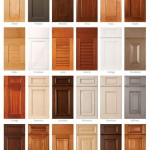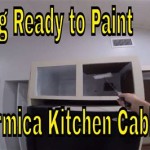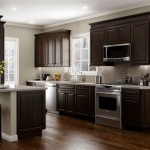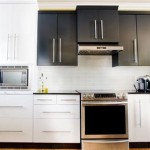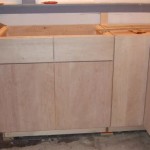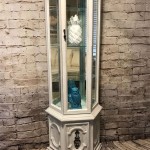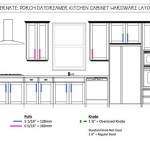How To Paint Wood Kitchen Cabinets Without Sanding
Refacing or replacing kitchen cabinets can be a significant expense. For homeowners seeking a cost-effective alternative to update the look of their kitchen, painting wood cabinets is an attractive option. While traditional methods often involve extensive sanding to ensure proper paint adhesion, advancements in primers and paints have made it possible to paint wood kitchen cabinets without sanding, streamlining the process and minimizing the mess.
This article provides a comprehensive guide on how to achieve a professional-looking finish on wood kitchen cabinets without resorting to sanding. It outlines the necessary materials, detailed step-by-step instructions, and essential tips to ensure a durable and visually appealing result.
Key Point 1: Preparing the Cabinets for Painting
The success of painting wood kitchen cabinets without sanding hinges on thorough preparation. This stage involves cleaning, degreasing, and applying a bonding primer that promotes paint adhesion. Neglecting these steps can lead to peeling, chipping, and an overall unsatisfactory finish.
The first step is to remove all cabinet doors and drawers. Label each one and its corresponding cabinet frame with painter's tape and a marker. This is crucial for proper reinstallation. Remove all hardware, including knobs, pulls, hinges, and drawer slides. Store the hardware in labeled bags to keep them organized and prevent loss. Consider whether you want to reuse existing hardware or upgrade to new pieces. This is an opportune time to update the aesthetic of your kitchen.
Once the cabinets are stripped, thoroughly clean all surfaces with a degreasing cleaner. Kitchen cabinets accumulate grease, grime, and food residue, which can interfere with primer and paint adhesion. Use a strong degreaser specifically designed for kitchen use, following the manufacturer's instructions. Apply the cleaner with a clean cloth or sponge, scrubbing gently to remove all traces of dirt and grease. For stubborn stains, allow the cleaner to dwell for a few minutes before wiping clean. Multiple cleaning passes may be necessary.
After degreasing, rinse all surfaces with clean water to remove any residual cleaner. Use a clean, damp cloth to wipe down the cabinets, ensuring all traces of the degreaser are gone. Allow the cabinets to dry completely before proceeding to the next step. This is a critical step, as moisture can prevent proper primer adhesion.
Inspect the cabinets for any imperfections, such as dents, scratches, or cracks. Fill these imperfections with wood filler, applying it according to the manufacturer's instructions. Allow the wood filler to dry completely, and then use a fine-grit sanding sponge (220 grit or higher) to lightly smooth the filled areas. This step, while not a full sanding of the entire cabinet, ensures a smooth and even surface for the primer.
Finally, wipe down the cabinets again with a tack cloth to remove any dust or debris created during the cleaning and filling process. A tack cloth is a slightly sticky cloth that effectively picks up fine particles, ensuring a clean surface for priming.
Key Point 2: Priming for Adhesion
The selection and application of a bonding primer are paramount when painting wood kitchen cabinets without sanding. A bonding primer is specifically formulated to adhere to slick surfaces, providing a stable base for the topcoat of paint. Standard primers may not provide sufficient adhesion on cabinets that have a glossy or varnished finish.
Choose a high-quality bonding primer designed for use on glossy or non-porous surfaces. Look for primers that specifically mention "adhesion promoting" or "bonding" in their product description. Epoxy-based primers and acrylic urethane primers are generally good choices for this application. Read the product label carefully to ensure it is compatible with the type of paint you plan to use for the topcoat.
Before applying the primer, ensure the work area is well-ventilated. Cover the surrounding surfaces with drop cloths to protect against spills and splatters. Wear appropriate safety gear, including gloves and a respirator, to protect yourself from fumes and paint particles.
Apply the primer in thin, even coats using a high-quality brush or roller. A brush is ideal for painting intricate details and corners, while a roller provides a smoother finish on larger, flat surfaces. Use a brush with synthetic bristles for water-based primers and a brush with natural bristles for oil-based primers. When using a roller, choose a low-nap roller cover to minimize stippling.
Work in sections, applying the primer evenly and avoiding drips or runs. Overlapping strokes slightly to ensure complete coverage. Pay close attention to edges and corners, ensuring they are fully primed. Allow the primer to dry completely according to the manufacturer's instructions. Drying times can vary depending on the type of primer and the ambient temperature and humidity.
After the first coat of primer has dried, inspect the surface for any imperfections or areas that may require additional attention. Lightly sand any rough spots with a fine-grit sanding sponge (320 grit or higher). Wipe down the cabinets with a tack cloth to remove any sanding dust before applying a second coat of primer. Applying two coats of primer ensures optimal adhesion and provides a more uniform base for the topcoat of paint.
Key Point 3: Painting and Finishing
Once the primer has completely dried and cured, the cabinets are ready for painting. The choice of paint and application technique will significantly impact the final appearance and durability of the cabinets. Selecting a paint that is specifically formulated for cabinets and following proper painting techniques is crucial for a professional-looking finish.
Choose a high-quality paint specifically designed for cabinets and trim. Acrylic latex or alkyd paints are generally recommended for kitchen cabinets due to their durability and ease of cleaning. Consider the desired sheen level. Semi-gloss and gloss finishes are more durable and easier to clean, making them ideal for kitchen cabinets. However, they also highlight imperfections more readily than satin or matte finishes.
Before painting, stir the paint thoroughly to ensure a consistent color and finish. If necessary, thin the paint according to the manufacturer's instructions. Thinning can improve the paint's flow and reduce brush or roller marks. Use a clean container for thinning, and add the thinner gradually, stirring thoroughly after each addition.
Apply the paint in thin, even coats, using the same techniques as with the primer. Use a high-quality brush or roller, depending on the desired finish and the complexity of the cabinet design. Work in sections, overlapping strokes slightly to ensure complete coverage. Avoid applying the paint too thickly, as this can lead to drips, runs, and uneven drying.
Allow the first coat of paint to dry completely according to the manufacturer's instructions. Drying times can vary depending on the type of paint and the ambient conditions. After the first coat has dried, lightly sand any imperfections with a fine-grit sanding sponge (320 grit or higher). Wipe down the cabinets with a tack cloth to remove any sanding dust before applying a second coat of paint.
Apply a second coat of paint, using the same techniques as the first coat. The second coat will provide better coverage, depth of color, and durability. Allow the second coat to dry completely and cure according to the manufacturer's instructions. Curing can take several days or even weeks, depending on the type of paint. Avoid using the cabinets heavily during the curing period to allow the paint to fully harden.
Once the paint has fully dried and cured, reinstall the hardware, cabinet doors, and drawers. Ensure all hardware is securely fastened. If you are using new hardware, take care not to overtighten the screws, as this can damage the cabinets. Carefully align the doors and drawers to ensure they close properly. Adjust the hinges as needed to achieve a consistent gap between the doors and drawers.
Clean up any spills or drips immediately with a damp cloth. Dispose of used brushes, rollers, and paint cans responsibly, following local regulations. Inspect the finished cabinets for any imperfections or areas that may require touch-up. Use a small brush to touch up any blemishes with the same paint used for the topcoat.
With proper preparation, priming, and painting techniques, it is possible to achieve a professional-looking finish on wood kitchen cabinets without sanding. This cost-effective alternative to refacing or replacing cabinets can transform the look of a kitchen and increase its value.

How To Paint Kitchen Cabinets Without Sanding Or Priming

How To Paint Laminate Cabinets Without Sanding The Palette Muse

How To Paint Kitchen Cabinets Without Sanding Sustain My Craft Habit

Painting Over Oak Cabinets Without Sanding Or Priming Hometalk

How To Paint Kitchen Cabinets Without Sanding The Budget Decorator

How To Paint Fake Wood Kitchen Cabinets Simple Made Pretty 2024

How To Paint Cabinets Without Sanding

How To Paint Oak Cabinets Without Sanding 100 Room Challenge Week 2 A Heart Filled Home Diy Decor

How To Paint Kitchen Cabinets Without Sanding Diy Hometalk

The Best Way To Paint Kitchen Cabinets No Sanding Palette Muse
Related Posts

